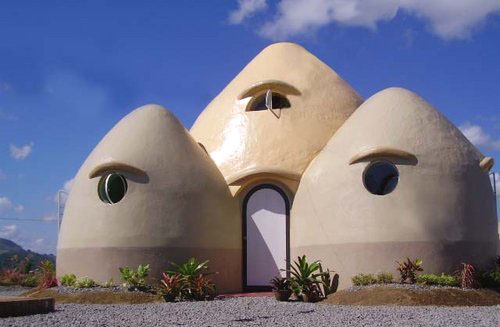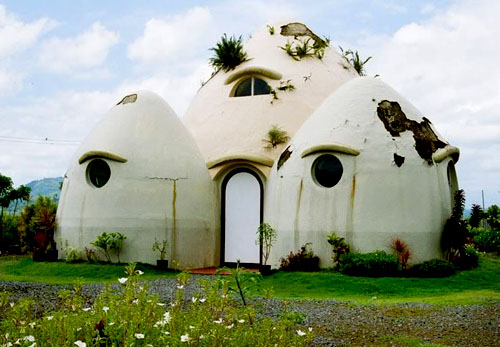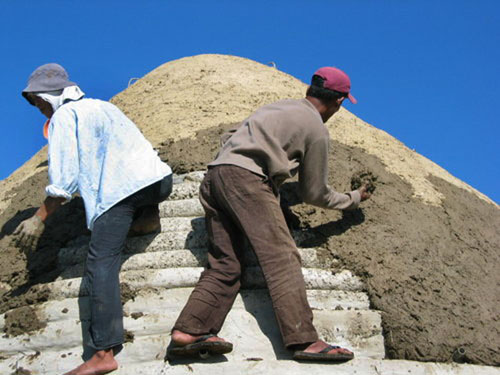In 2005 there was much publicity and delight regarding a lovely earthbag clinic built in a small town in the Philippines. This was a project of Illac Diaz and several organizations there. You can see the finished building below.

Since then it has been privately reported that the building has fallen into disrepair. Some photos accompanying the report clearly show that this is the case:

So what happened? Here is what I think. You can see in the photo below how the workmen are applying mud to the cement-stabilized earthbag structure.

Obviously the final layer of plaster did not adhere to the mud fill that was applied. Plants are now growing naturally in this earthen medium; the seeds or roots may have been present at the time it was applied.
What this indicates to me is that the intermediate mud plaster was a mistake, and it should have been replaced by more stabilized material like what was placed in the earthbags. Then the final color coat of compatible plaster would likely have remained intact, and nothing would be growing up there.
It is a sad commentary that despite such a lovely structure having been built, there is not sufficient interest, or follow-through to remedy the situation and salvage the entire building.
To read about the entire project and see more photos see www.earthbagbuilding.com

this is the Philippines. nobody cares about maintaining anything here.
Any news, updates concerning this once beautiful structure?
WE CARE!! We are presently researching how to cover our earthbag domes so this doesn’t happen! Ours have no earthen plaster though as we are building with different indigenous materials.
The general practice here is to let a building (bamboo and nipa) fall down and then you build a new one; I guess no one explained maintenance to them. We would buy it but its not in a very convenient location, and its much more fun to build your own.
Kelly I emailed our problem to you, i guess you could post it here in case anyone else in the Philippines is reading this. I have also got in touch with a man who specializes in historical renovation of churches here in the Philippines, so he may be able to give us some educated local advice (the normal one being, concrete.)
Thanks for this page it’s great.
i think this house is a great idea. i was thinking why not really let a palnt gorw all over the house. i often se this plant with small leaves that covers a whole wall. i just can’t recall the name. maybe this plant can hold the structure together. just a thought. i really like this house. we have a land and building a conventional house is well. . not in my budget.
i welcome comments and suggestions at linusjcmlopez@gmail.com.
thank you.
It is possible to design a house to have a living roof, and Owen Geiger did this with his small dome featured at http://earthbagbuilding.wordpress.com/2009/07/15/low-cost-multipurpose-minibuilding-made-with-earthbags/ .
Unfortunately, unless the building is built with this in mind, it will likely leak water inside, and I am afraid that this is what will happen with the dome in the Philippines.
Unfortunately, no one in the Phillipines appears to appreciate what they have there. To buy it cheap isn’t so much the problem as the cost of getting there & back is.
Somebody should buy this cheap and fix it up. What looks like a total loss is likely only skin deep. The stabilized earthbags are almost certainly still sound. Hire a couple laborers, peel off the plaster and redo it.
I came across your site & have found answers to every question I have come up with regarding building in this way – which I thought I might have thought of. No shame that I didn’t – it just proves that ‘great’ minds run in the same ways. As for the buildings which are disintegrating – since all building need maintenance, I believe the shame comes from & to the people there not doing whatever it takes to fix the problem. If they wanted to be sure no seeds would germinate if any had gotten into the mud in-fill, it seems to me that bleach, worked into the mud & left to ‘work’ for a short time before application, would have solved the problem. The chlorine in the bleach oxidizes & passess off, so there would be no odor in the building. Otherwise, every so often, someone needs to climb a ladder searching for & removing sprouts – or they plan for a green roof from the start & go that route. None of what happened ‘had’ to, & even now it isn’t irreparable. More elbow-grease, less goofing off.
Very sad, indeed…
Another possibility is moisture got in through cracks in the plaster and caused the earthen layer below to expand. Let’s hope the designer offers an explanation so others can learn from this unfortunate mistake.